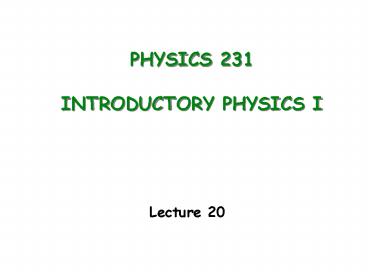PHYSICS 231 INTRODUCTORY PHYSICS I - PowerPoint PPT Presentation
Title:
PHYSICS 231 INTRODUCTORY PHYSICS I
Description:
If we extend the mass, and let go, the pen traces a sine wave. Graphing x vs. t ... Phase of 90-degrees changes cosine to sine. for peak at. a. x. v. Velocity is 90 ... – PowerPoint PPT presentation
Number of Views:57
Avg rating:3.0/5.0
Title: PHYSICS 231 INTRODUCTORY PHYSICS I
1
PHYSICS 231INTRODUCTORY PHYSICS I
- Lecture 20
2
Last Lecture
- Heat Engine Refrigerator, Heat
Pump
3
Entropy
- Measure of Disorder of the system(randomness,
ignorance) - Entropy S kBlog(N) N of possible
arrangements for fixed E and Q
Number of ways for 12 molecules to arrange
themselves in two halves of container.
S is greater if molecules spread evenly in both
halves.
4
2nd Law of Thermodynamics(version 2)
The Total Entropy of the Universe can never
decrease.
(but entropy of system can increase or decrease)
- On a macroscopic level, one finds that adding
heat raises entropy
Temperature in Kelvin!
5
Why does Q flow from hot to cold?
- Consider two systems, one with TA and one with
TB - Allow Q gt 0 to flow from TA to TB
- Entropy changes by DS Q/TB - Q/TA
- This can only occur if DS gt 0, requiring TA gt
TB. - System will achieve more randomness by
exchanging heat until TB TA
6
Carnot Engine
- Carnot cycle is most efficient possible, because
the total entropy change is zero. - It is a reversible process.
- For real engines
7
Chapter 13
Vibrations and Waves
8
Hookes Law Reviewed
- When x is positive ,F is negative
- When at equilibrium (x0), F 0
- When x is negative ,F is positive
9
Sinusoidal Oscillation
- If we extend the mass, and let go, the pen traces
a sine wave.
10
Graphing x vs. t
11
Period and Frequency
A
T
Amplitude A Period T Frequency f 1/T Angular
frequency ?
12
Phases
Often a phase ??is included to shift the timing
of the peak
for peak at
Phase of 90-degrees changes cosine to sine
13
Velocity and Acceleration vs. time
T
- Velocity is 90 out of phase with x When x is
at max,v is at min .... - Acceleration is 180 out of phase with x a
F/m - (k/m) x
T
T
14
v and a vs. t
Find vmax with E conservation
Find amax using Fma
15
Connection to Circular Motion
Projection on axis
circular motion with constant angular velocity ?
Simple Harmonic Motion
16
What is w?
Simple Harmonic Motion Cons. of E
Circular motion Angular speed ? Radius A gt
Speed vA?
17
Formula Summary
18
Example13.1
- An block-spring system oscillates with an
amplitude of 3.5 cm. If the spring constant is
250 N/m and the block has a mass of 0.50 kg,
determine (a) the mechanical energy of the
system (b) the maximum speed of the block(c)
the maximum acceleration.
a) 0.153 J b) 0.783 m/s c) 17.5 m/s2
19
Example 13.2
A 36-kg block is attached to a spring of constant
k600 N/m. The block is pulled 3.5 cm away from
its equilibrium positions and released from rest
at t0. At t0.75 seconds,a) what is the
position of the block? b) what is the velocity
of the block?
a) -3.489 cm b) -1.138 cm/s
20
Example 13.3
A 36-kg block is attached to a spring of constant
k600 N/m. The block is pulled 3.5 cm away from
its equilibrium position and is pushed so that is
has an initial velocity of 5.0 cm/s at t0. a)
What is the position of the block at t0.75
seconds?
a) -3.39 cm
21
Example 13.4a
An object undergoing simple harmonic motion
follows the expression,
Where x will be in cm if t is in seconds
The amplitude of the motion is a) 1 cm b) 2
cm c) 3 cm d) 4 cm e) -4 cm
22
Example 13.4b
An object undergoing simple harmonic motion
follows the expression,
Here, x will be in cm if t is in seconds
The period of the motion is a) 1/3 s b) 1/2 s c)
1 s d) 2 s e) 2/? s
23
Example 13.4c
An object undergoing simple harmonic motion
follows the expression,
Here, x will be in cm if t is in seconds
The frequency of the motion is a) 1/3 Hz b) 1/2
Hz c) 1 Hz d) 2 Hz e) ? Hz
24
Example 13.4d
An object undergoing simple harmonic motion
follows the expression,
Here, x will be in cm if t is in seconds
The angular frequency of the motion is a) 1/3
rad/s b) 1/2 rad/s c) 1 rad/s d) 2 rad/s e) ?
rad/s
25
Example 13.4e
An object undergoing simple harmonic motion
follows the expression,
Here, x will be in cm if t is in seconds
The object will pass through the equilibrium
positionat the times, t _____ seconds a) ,
-2, -1, 0, 1, 2 b) , -1.5, -0.5, 0.5, 1.5,
2.5, c) , -1.5, -1, -0.5, 0, 0.5, 1.0, 1.5,
d) , -4, -2, 0, 2, 4, e) , -2.5, -0.5, 1.5,
3.5,































